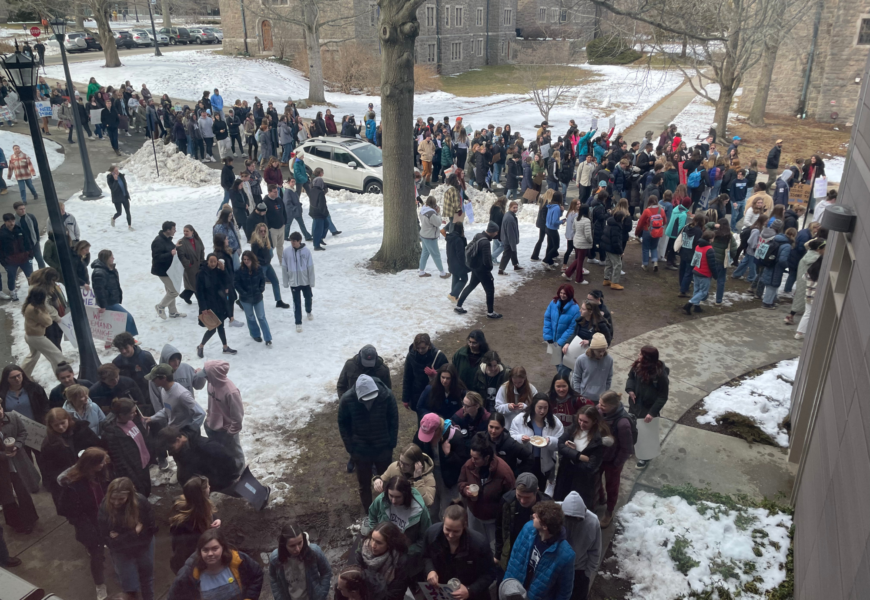Photo courtesy of Minnie Madden ’26
Cheron Morris, who currently works as an attorney, came to Connecticut College in 1985. She had been interested in the school since attending the Minority Freshman Weekend – an event put on at Unity House. Conn resembled the private school Morris had attended prior – and she recalled fondly noting how “welcoming and inviting the students of color were.” She thought, like many minority students today, that “Conn would be a great place to land” learning shortly after, however, that the vision of the College she had observed on Minority Freshman Weekend was a spectacle rather than reality.
Once on campus, Morris became heavily involved in UMOJA – an organization that was very engaged with faculty and the administration to try and enact change on campus. Her freshman year was spent in countless meetings with deans and faculties advocating for the creation of an African Studies major, increasing the hiring of professors of color and making the entire college community more reflective of the diverse student body. She reminisces “it was a lot of listening but no action. No promises. No anything.” During this process, Morris came into contact with Frank Tuitt, another student activist at Conn who now deserves as the Diversity Chief at UConn. Tuitt was involved in SOAR – a north-east organization that had chapters at many colleges that at Conn consisted mostly of white students. The SOAR chapter brought speakers to campus, such as Charles King and Jane Elliot – icons of anti-racism work at the time. SOAR’s visits inspired Tuitt and others to make the college more inclusive.
Umoja, La Unidad, the Gay-Straight-Bi Alliance and SOAR student members, enraged at the stagnant nature of creating change on campus, rallied at Unity House. One student suggested they mimic what happened in 1971 on campus and take over Fanning. Tuitt remembers students in the room initially chuckled at the idea, but it quickly became serious.. They decided they would occupy Fanning within 48 hours of this meeting. Thus with the idea firmly planted the crucial question arose: how do you occupy the building?
The plan unfolded that a SOAR student named Sheila Gallagher alongside another gentleman stayed in Fanning after hours. The two hid in a bathroom/infirmary. When campus safety entered the building to check, he heard the two students. To disguise their operation, the two students pretended they were making out. Escorted out from their ‘escapades’ behind campus safety, Sheila dropped her glove in the door, leaving the building open for students to enter.
Next, a phone tree went off with students calling other students explaining they had done it! When everyone was called, the students tiptoed across Temple Green, sneaking into the building in the wee hours of the morning. With around 52 students inside, the doors were chained shut with the lower windows also fastened after 2 more students climbed through windows to occupy. While the architects discussed what should happen next, Morris called her mother on the payphone:
“My mother flipped out and told me in no uncertain terms, are you staying in that building? You get out immediately. You knew what this college had and didn’t have before you accepted. Deal with it. So I hung up on her and called my aunt. My aunt said you stay in the building and fight for your rights. Just don’t be the spokesperson as they always get in trouble!”
So Morris decided to stay. By about 5 in the morning, the sun was coming up. Folks were hanging banners out the windows, as Campus Safety began their morning shift. The officers screamed at the occupiers “Get out of the building!” Soon after, the first professor arrived for work to the rude awakening of students cheering that “Fanning is closed today!”
Realizing the occupiers were now committed, students inside called all the local news officers to spread the word that Fanning had been occupied. Helicopters arrived, and students flooded the scene. One history professor told his students you stand here as this is history in the making. It is important to note, though, that many students were against the ‘86 Fanning Takeover. Many were outraged that the protest was stealing their parents’ money since they could not attend class. Tuitt recalls his fellow occupiers were deemed “weekend rebels” by some of their classmates for staging this protest.
Professor Hampton was instrumental in brokering communication between students and the administration. Alongside another faculty member, the occupying students invited Hampton into the building to negotiate on terms. Tuitt explained “there were some very tense moments regarding under what terms students would leave and who would make that decision. Whilst we framed it as a take-over, the occupation was an attempt to improve the education of all kinds of students.” By the end of the day, a list of 8 demands was set on with an administration agreeing to college-wide changes. At the time, students wanted a fully-fledged African Studies program; a demand that the college met. Professor Hampton became Dean Hampton – the only black professor that Morris remembers from her freshman year.
Morris reflects “the occupation was the easy part. The hard part was everything after. All the committees formed to realize these promises. These occurred throughout my sophomore year. Looking back, that was probably the year I did the worst in school, as I was heavily involved in everything other than performing well in school. It was very taxing on a lot of minority students who were heavily involved in trying to affect change. It in some ways soured my experience at Conn. By the time I got to junior year, I wanted nothing to do with any of this. I was so angry that my experience sophomore year was all about trying to affect change at a college that should have afforded me the same opportunities it did to its white students.” Tired from a year of advocacy, Morris spent her junior year involved in nothing. She desired to just hang out with friends and not be political.
“Connecticut College, the board, and the administration always have had good intentions. But as my mother has said, the path to hell is paved with good intentions. You need to step back and reflect on what this institution is providing, and what we are here to do as an administration: to serve and educate students. Students who are our greatest resources will reflect wonderfully on the institution that educated them, allowed them to grow, and gave them experiences working with differences in culture, background and languages. That is what should be sent out into the world. If you don’t provide the same equitable opportunity to everyone, you will not get that. The truth will be revealed, and that is what is happening now”
When watching the live-streamed meeting of students speaking to the BoT before the occupation, Morris expressed, “I have never been so shocked. I literally thought that the one thing I knew about Connecticut College was that, in spite of the fact I don’t feel like I could bring my full self there, that was because of my social, cultural and educational experience. I was shocked at all the information I received about living conditions. The overcrowding and deplorable conditions are not on. The school is meeting minimum thresholds but not even sustaining them”
Finally, Morris reminded me of the context surrounding Fanning 1986. It is important to remember that, at the time, DIEI work was only about diversity. No efforts were occurring towards equity, inclusion or social justice. There was a lack of advocacy to make minority students consulted in decision-making. She elaborated that “this is an institution, likely a racist institution as most education institutions are or, more accurately, discriminatory for it is not just about race. How do we deal with changing things without dismantling the institution and its education? How do we weave in all things necessary for anyone different from the norm to be all right living there? I don’t think this has not happened in American Education systems. There is this push and pull. What we thought was changed was simply window dressing. Hiring more black professors, just window dressing. Connecticut College is at an inflexion point. And the students now are much more sophisticated, engaged and thoughtful about what change looks like than we ever were. Conn College cannot get away with window dressing anymore!”










